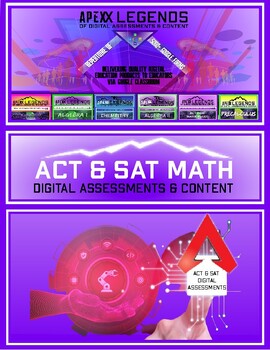SAT Passport To Advanced Mathematics (Level 1 to Level 5) Google Form #1
- PDF
- Google Apps™

What educators are saying
Description
Hello! Elevate your radical lessons with our self-grading Google Forms assessment with forty (40) SAT-Level Advanced Mathematics questions (mix of multiple-choice & fill-in-the-blank questions).
Goals of This Digital Assessment: Passport to Advanced Math questions ask students to:
- Create a quadratic or exponential function or equation that models a context. The equation will have rational coefficients and may require multiple steps to simplify or solve.
- Determine the most suitable form of an expression or equation to reveal a particular trait, given a context.
- Create equivalent expressions involving rational exponents and radicals, including simplifying or rewriting in other forms.
- Create an equivalent form of an algebraic expression by using structure and fluency with operations.
- Solve a quadratic equation with rational coefficients. The equation can be presented in a wide range of forms to reward attention to algebraic structure, and can require manipulation to solve.
- Add, subtract, and multiply polynomial expressions, and simplify the result. The expressions will have rational coefficients.
- Solve an equation in one variable that contains radicals or contains the variable in the denominator of a fraction. The equation will have rational coefficients, and the student may be required to identify when a resulting solution is extraneous.
- Solve a system of one linear equation and one quadratic equation. The equations will have rational coefficients.
- Rewrite simple rational expressions. Students will add, subtract, multiply, or divide two rational expressions or two polynomial expressions and simplify the result. The expressions will have rational coefficients.
- Interpret parts of nonlinear expressions in terms of their context. Students will make connections between a context and the nonlinear equation that models the context to identify or describe the real-life meaning of a constant term, a variable, or a feature of the given equation.
- Understand the relationship between zeros and factors of polynomials, and use that knowledge to sketch graphs. Students will use the properties of factorable polynomials to solve conceptual problems relating to zeros, such as determining whether an expression is a factor of a polynomial based on other information provided.
- Understand a nonlinear relationship between two variables by making connections between their algebraic and graphical representations. The student will select a graph corresponding to a given nonlinear equation; interpret graphs in the context of solving systems of equations; select a nonlinear equation corresponding to a given graph; determine the equation of a curve given a verbal description of a graph; determine key features of the graph of a linear function from its equation; or determine the impact on a graph of a change in the defining equation.
- Use function notation, and interpret statements using function notation. The student will use function notation to solve conceptual problems related to transformations and compositions of functions.
- Use structure to isolate or identify a quantity of interest in an expression or an equation. The student will rearrange an equation or formula to isolate a single variable or a quantity of interest.
Example Problem: [Without Calculator] The total surface area of a cube is 96k. What is the volume of the cube?
a. 64k
b. 64√k
c. 64k²
d. 384k√6k
Technical Details About the Google Forms Assessment:
- ALL digital assessments provided are completely editable. (NOTE: If answers in the Google Form(s) you purchase are digital, you MUST HAVE Equatio installed and set up for this to be true.).
Here is the name of the document you will receive a link to in the PDF if you purchase this resource:
- SAT Passport To Advanced Mathematics (Level 1 to Level 5) Google Form #1 (40 Questions)
Thank you for viewing this product and for supporting our TPT Store (APEXX Legends)! If you like this resource, please rate it and follow us on Instagram: @apexxlegendsllc
Sincerely,
APEXX Legends
NOTE: Passport to Advanced Math is one of the three SAT Suites of Assessment Math sub-scores, reported on a scale of 1 to 15.





